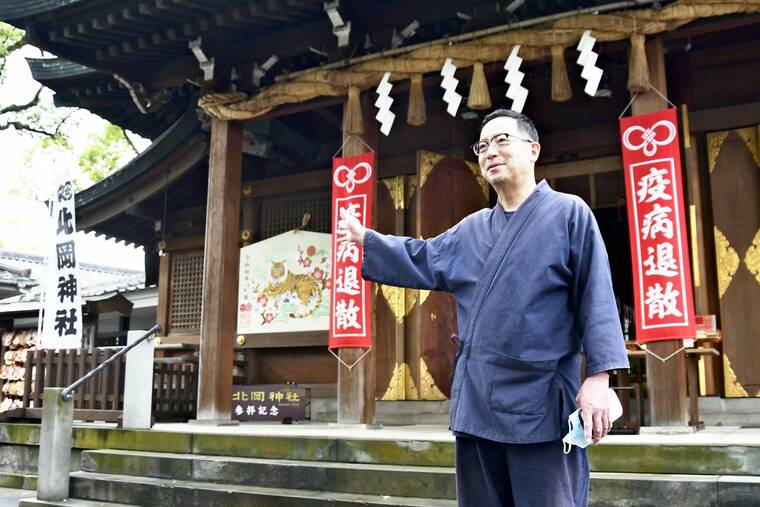Sacred temples, shrines could serve as shelters

JAPAN NEWS-YOMIURI
Shinichiro Iseri, chief priest at Kitaoka Shrine in Nishi ward, Kumamoto, recalls how the shrine accommodated people following the Kumamoto earthquake in April 2016.
TOKYO >> Temples, shrines and other religious structures across Japan are increasingly being considered for use as evacuation shelters during natural disasters.
Buildings owned by religious organizations often are located on higher ground near residential areas, and many have large spaces and cooking facilities. During disasters such as the 2011 Tohoku and 2016 Kumamoto earthquakes, many people found shelter at religious buildings.
More and more local governments are signing cooperation agreements for use of religious facilities to help mitigate the effects of disaster events. Those arrangements could help many residents. If an earthquake were to occur over the Kego fault belt, for example, an estimated 190,000 Fukuoka residents would be unable to return to their homes.
Kokunji, a Buddhist temple in the city’s Hakata ward, is setting up manhole toilets, which during an emergency would be directly connected to the sewage system.
The temple signed a contract with the city in 2018 to accommodate people around the JR Hakata train station. If a disaster were to occur, the temple could house 144 people for up to three days in its hall and guest rooms.
“We’ve been stocking up on drinking water and preserved foods to prepare for an emergency,” said 51-year-old Shinsui Kobayashi, the temple’s chief priest.
Don't miss out on what's happening!
Stay in touch with breaking news, as it happens, conveniently in your email inbox. It's FREE!
In a survey of municipalities across Japan in 2019 and 2020 by Osaka University professor Keishin Inaba, 661 religious organizations had signed cooperation agreements with local governments. Since 2014, the number of religious organizations entering similar agreements has more than doubled.
In Nogata, Fukuoka prefecture, six of the city’s 50 evacuation shelters are religious facilities, mainly temples and shrines. Nogata residents have long evacuated to temples in times of disaster.
But it was the Tohoku disaster in 2011 that prompted the government to turn to temples and shrines for evacuation sites. Those affected by the Tohoku quake could not all be accommodated in school gyms, town halls and other traditional evacuation spaces, and more than 100 locations were pressed into service.
At Kitaoka Shrine in Nishi ward, Kumamoto, a concrete hall comprising Japanese-style rooms and a kitchen was used as an evacuation shelter following the 2016 Kumamoto earthquake. About 20 people stayed at the hall, some for as long as 10 days. The temple’s chief priest, Shinichiro Iseri, said, “If a large-scale disaster occurs in the future, we’ll do our utmost to make aid available.”
For its part, the central government is requesting that local governments collaborate with religious organizations to prepare for possible disasters. The Cabinet Office’s guidelines on evacuation shelter management encourages local governments to designate temples, shrines and other religious facilities as shelters.
There are some hurdles to clear, including better communication. During past disasters, some local governments didn’t think it was possible for aid supplies to be provided to religious organizations. And there continue to be concerns about cultural assets being damaged while a temple or shrine is serving as a shelter.
To avoid trouble, Inaba emphasized the importance of disaster-related arrangements being spelled out in advance. “The central and local governments should formulate aid measures, including budget allocations.”



